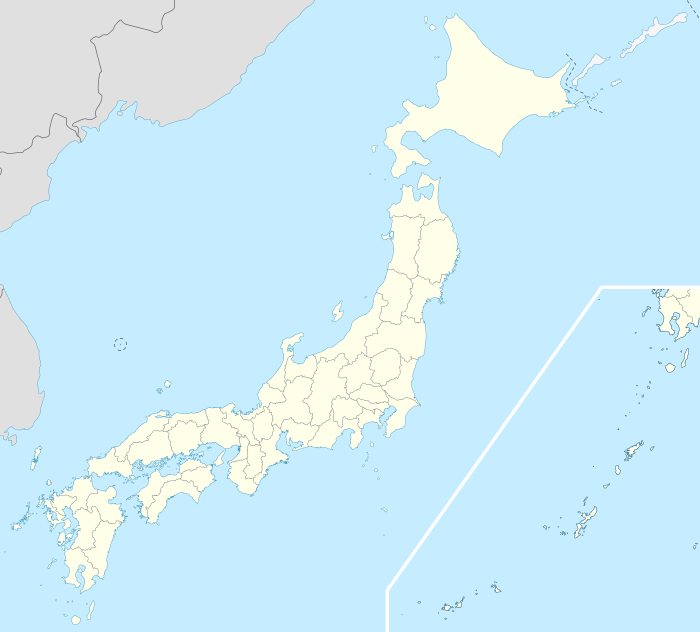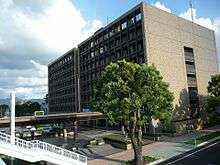Miyakonojō
| Miyakonojō 都城市 | ||
|---|---|---|
| City | ||
|
View of downtown Miyakonojo, from Miyakonojo Castle Ruin Park | ||
| ||
 Location of Miyakonojō in Miyazaki Prefecture | ||
 Miyakonojō Location in Japan | ||
| Coordinates: 31°43′N 131°4′E / 31.717°N 131.067°ECoordinates: 31°43′N 131°4′E / 31.717°N 131.067°E | ||
| Country | Japan | |
| Region | Kyushu | |
| Prefecture | Miyazaki Prefecture | |
| Government | ||
| • Mayor | Makoto Nagamine | |
| Area | ||
| • Total | 653.31 km2 (252.24 sq mi) | |
| Population (November 1, 2012) | ||
| • Total | 168,072 | |
| • Density | 257.26/km2 (666.3/sq mi) | |
| Symbols | ||
| • Tree | Japanese zelkova | |
| • Flower | Iris | |
| • Flowering tree | Camellia sasanqua | |
| Time zone | Japan Standard Time (UTC+9) | |
| City hall address |
6-21 Himegichō, Miyakonojō-shi, Miyazaki-ken 885-8555 | |
| Website |
www | |
Miyakonojō (都城市 Miyakonojō-shi) is a city in Miyazaki Prefecture, Japan. The city was founded on April 1, 1924.
As of November 1, 2012, the city has an estimated population of 168,072, with 70,549 households and a population density of 257.26 per km². The total area is 653.31 km² making it the largest city in the prefecture in terms of area.
On January 1, 2006, the towns of Takajō, Takazaki, Yamada and Yamanokuchi (all from Kitamorokata District) were merged into Miyakonojō.
History
Miyakonojō is known as the birthplace of the Shimazu Estate, the largest shōen (estate or manor) of medieval Japan. In the 1020s, a powerful official named Taira no Suemoto developed a small manor named Shimazu-in. Expanded substantially in the first half of the 12th century, it eventually covered large portions of Satsuma, Ōsumi and Hyūga Provinces. In 1185, Koremune no Tadahisa was appointed as jitō of the Shimazu Estate and thereafter claimed the clan name of Shimazu. It is said that one of Tadahisa's residences, called Iwayoshi Gosho, was located at Miyakonojō. Between the Muromachi period and Edo period, the Hōngō family, which was a branch family of the Shimazus, controlled the area. After the Boshin War, it became one of the cities to abolish the han system. In 1871, it became a prefecture for a year.
Industry
Many of Miyakonojō's citizens work as farmers. They produce gobō, meat, and bell peppers. Miyakonojō is also home to some agriculture-related manufacturing.
Miyakonojō is also famous for producing traditional Japanese archery bows from the abundant bamboo in the area.[1]
Schools
Miyakonojō has 35 elementary schools and 19 junior high schools.
Notable residents
- Tomoji Tanabe, the world's oldest man 1895-2009, was born and lived in Miyakonojō.[2]
- Kōsei Inoue, Olympic Gold Medalist in Judo.
- Gōgen Yamaguchi, known as "The Cat", was a renowned martial arts master of the Gōjū-ryū style of Karate.
- Jūzō Yamasaki, the manga artist was born in Miyakonojō.
- Hideo Higashikokubaru, a famous comedian and the former Governor of Miyazaki.
Nearby municipalities

Climate
Miyakonojō has a humid subtropical climate (Köppen climate classification Cfa), but is cooler than other cities in Miyazaki. The average temperature is about 16 °C, and it rains less than in Miyazaki City. The area's climate is influenced by its proximity to mountains.
| Climate data for Miyakonojō, Miyazaki | |||||||||||||
|---|---|---|---|---|---|---|---|---|---|---|---|---|---|
| Month | Jan | Feb | Mar | Apr | May | Jun | Jul | Aug | Sep | Oct | Nov | Dec | Year |
| Average high °C (°F) | 11.3 (52.3) |
12.5 (54.5) |
15.9 (60.6) |
20.9 (69.6) |
24.3 (75.7) |
26.8 (80.2) |
30.7 (87.3) |
31.3 (88.3) |
28.4 (83.1) |
23.9 (75) |
18.8 (65.8) |
13.7 (56.7) |
21.54 (70.76) |
| Daily mean °C (°F) | 5.0 (41) |
6.5 (43.7) |
9.8 (49.6) |
15.1 (59.2) |
18.8 (65.8) |
22.2 (72) |
26.0 (78.8) |
26.1 (79) |
23.2 (73.8) |
17.7 (63.9) |
12.3 (54.1) |
6.9 (44.4) |
15.8 (60.44) |
| Average low °C (°F) | −0.4 (31.3) |
1.2 (34.2) |
4.2 (39.6) |
9.8 (49.6) |
14.0 (57.2) |
18.4 (65.1) |
22.5 (72.5) |
22.4 (72.3) |
19.2 (66.6) |
12.6 (54.7) |
6.7 (44.1) |
1.2 (34.2) |
10.98 (51.78) |
| Average precipitation mm (inches) | 60.4 (2.378) |
91.1 (3.587) |
150.8 (5.937) |
223.3 (8.791) |
253.6 (9.984) |
424.9 (16.728) |
343.1 (13.508) |
340.6 (13.409) |
262.6 (10.339) |
115.3 (4.539) |
78.5 (3.091) |
51.5 (2.028) |
2,395.7 (94.319) |
| Average snowfall cm (inches) | 1 (0.4) |
1 (0.4) |
0 (0) |
0 (0) |
0 (0) |
0 (0) |
0 (0) |
0 (0) |
0 (0) |
0 (0) |
0 (0) |
0 (0) |
2 (0.8) |
| Average relative humidity (%) | 74 | 73 | 73 | 77 | 78 | 82 | 82 | 82 | 82 | 78 | 78 | 77 | 78 |
| Mean monthly sunshine hours | 172.5 | 151.5 | 166.4 | 153.3 | 157.3 | 128.6 | 190.4 | 199.1 | 158.5 | 177.8 | 161.7 | 172.1 | 1,989.2 |
| Source: NOAA (1961-1990)[3] | |||||||||||||
Current issues
Miyakonojō is experiencing a declining population. Several other cities in Miyazaki Prefecture are also facing this problem. Many schools are scheduled to close due to the declining population, which has resulted in fewer children.
References
- ↑ Miyakonojo daikyu (archery bows), Japan National Tourist Organization.
- ↑ Oldest man marks 112th birthday, BBC News, 18 September 2007.
- ↑ "Miyakonojo Climate Normals 1961-1990". National Oceanic and Atmospheric Administration. Retrieved January 6, 2013.
External links
- Miyakonojō City official website (Japanese)

